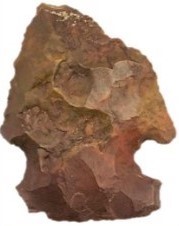
This projectile point was found in Fairfax County’s Riverbend Park in 2019 but was created by a skilled Native American between 6,000 and 2,500 B.C., during the period archaeologists refer to as Middle Archaic. During this period, Virginia Indians expanded the types of stone tools they created to hunt, fish, and build shelters. Projectile points can shed light on the people who made and used them, and this jasper point displays some unusual characteristics.
The jasper material in this point is not common in this region and is rarely heat treated. We can tell that the point was cracked during the heat-treating process due to the pot lid shapes that popped or kernelled away from the point under intense heat. There is a gradient of color from a deep maroon red at the base of the point to a light brown at the tip.

Heat-treated artifacts are important to archaeological interpretation because they provide another level of analysis. Archaeologists working on prehistoric sites find hearths or ground ovens that were typically lined with stones that experienced this heat treatment. Over time, the heat forced the stones to crack or split, producing Fire Cracked Rocks (FCR).
Archaeologists find a variety of stone tools or FCR that have a reddish or even lighter brown coloration which can vary based on the type of stone. This change in color is the result of being burned or heat treated.
There are several theories about why prehistoric people might have done this. One theory is that the process of burning the stone/tool helped strengthen it, which would have been beneficial for projectile points or tools mainly used for cutting or stabbing. Another theory is that heat treating the material was done purely for esthetic purposes and that the people simply preferred the changed color over the original. A third theory is that heat-treated projectile points/tools were burned during a ceremonial event.

